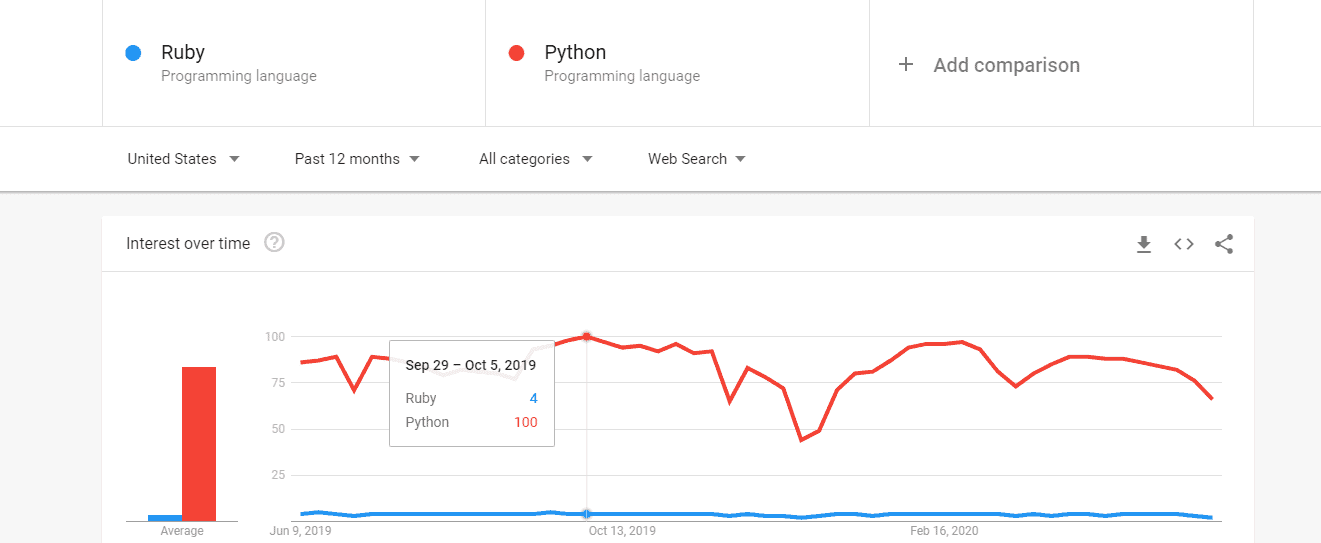The modern-age programming language – Python and Ruby are well-grounded, extensively-used, and globally accepted programming languages that are employed to formulate & maintain functional applications and sites. Today, we will talk about Ruby vs Python.
Many distinguished applications like Google and YouTube, were developed applying Python, while notable applications like Twitter and Hulu were formulated by utilizing Ruby.
Both the programming languages have loads of comparable characteristics. They are high-level, object-oriented, server-side scripting languages. Any Leading Python Web application Development Company can help you to know about Python and the same is the case with ruby.
Both incorporate standard libraries, interactive shell, resolution assistance, and feature-filling frameworks – Ruby’s Ruby on Rails (RoR) and Python’s Django. Their main focus is on simplicity, robust, and agile performance using fewer lines of code.
Despite their identities, Ruby and Python are poles apart in diverse matters like problem-solving, so it is quite essential that you are fully informed of the privileges and shortcomings of both the languages.
This article focuses on unveiling the contrast between Ruby as well as Python and to support it with proven facts, our adept developers have added their insights to strengthen the comparison and provide you with a clear understanding on the concept.
What Is Ruby: Features, Pros, and Cons
Ruby is an open-source, dynamic, reflective, general-purpose, and an absolute object-oriented programming language designed by the Japanese computer scientist Yukihiro Matsumoto in 1995.
It is famously-recognized as an extensible language because it empowers programmers to perform alterations to numerous components of the language when and if necessary.
Ruby can operate on all sorts of platforms like Mac OS, Windows, and all variants of UNIX. The greatest start-ups and corporations desire a strong digital ubiquity fancy Ruby because it is notably agile to develop scalable and sturdy web applications.
Moreover, coding in Ruby has been made human-expressive and effortless to understand. There are no primordial models in Ruby – everything is concerning objects!
A mere Hello World program is a singular line.
#“Hello World!”;
Ruby comments begin with ‘#’ exactly like in Python.

Features of Ruby
- Ruby is a sheer object-oriented programming language.
- It is a server-side scripting language, quite like Python.
- It can be used to write Common Gateway Interface (CGI) scripts.
- A parallel syntax like several programming languages. Perl and C++, for instance.
- Profoundly scalable, and large programs written in Ruby can be supervised efficiently.
- A vibrant assemblage of built-in functions, which can be employed straight into Ruby scripts.
Pros and Cons of Ruby
Pros
- It grants liberty to developers to be creative and implement productive solutions.
- A clear and straightforward syntax supporting new ror developers to learn pretty fast and efficiently.
- Ruby language was produced to make the developer’s work fun and fast, and it provides the facility of developing web apps of any dimension in less time.
Cons
- It is hard to debug tasks in Ruby.
- It allows lesser use cases other than web development.
- The documentation, community, and assistance on Ruby are restricted.
- Exceptional gems and libraries are challenging to find.
- There is a consistent drop in the prevalence of the Ruby language.
What Is Python: Features, Pros, and Cons
Python was conceptualized and devised by Dutch Programmer Guiddo van Rossum in 1991 stressing on code readability and its versatile usage. It is a universally accepted language for application development and is accessible on all cross-platform operating systems.
Python has a very simplistic and minimalistic feature that can tackle common programming tasks and its pseudo-code nature enables one to meditate on the resolution to the query and not the language.
Python is beginner-friendly and an excellent pick to start the programming adventure. The programs written are close to clear English – plain and easy. Businesses prefer to hire python experts to build projects on it.
“Hello World” in Python, just like Ruby, would be only a single line code.
print(“Hello World!”)
The only difference, though, is the usage of Print and nonexistence of semi-colon to finish the line.
Features of Python
- Python is convenient to read, interpret, and maintain.
- It can work on varied hardware platforms employing the very interface.
- Python proposes a unique composition and assistance for extensive utilization.
- It has an interactive technique of testing and debugging.
- It delivers high-level dynamic data types and also favors dynamic type checking.
- Statically linked binaries that are simple to deploy.
Pros and Cons of Python
Pros:
- Python has simplistic and easy-to-follow syntax even for Novices.
- It is object-oriented programming-driven.
- It backs crucial and functional programming.
- Python supports cross-platforms and systems.
- Open Source and extensive and powerful community backing.
Cons:
- Confined application in platforms.
- Low mobile computing potential, hence not exercised in-app development.
- As Python is dynamic, it exhibits higher errors at run-time.
- Restrictions in admittance due to the under-developed and primitive database.
- No commercial support and not the first pick for memory-intensive tasks.
What Ruby Is Used For?
Ruby has loads of web frameworks, of which Ruby on Rails is arguably the most successful one. Its third-party libraries are delivered as “gems” and can be introduced through RubyGems.
The libraries are also hosted on the public repository RubyGems.org and can also be located on GitHub.
Ruby may be a general-purpose language; however, the predominance of Ruby on Rails has commanded the comprehensive use of Ruby for producing web applications.
Ruby can also be a magnificent tool for start-ups as it enables to build a prototype swiftly and test primary ideas.
What Python Is Used For?
Python is highly flexible and versatile, which means it’s Python is a grand pick for a diversity of domains such as:
- web development,
- machine learning,
- start-ups,
- fintech,
- academia and science, and
- the Internet of Things.
Because of the plethora of pre-built libraries and frameworks, the utilization of Python has been possible on an extensive scale, making it more comfortable to implement and practice working resolutions.
Python also expedites development. Python’s easy-to-learn, friendly, and spontaneous syntax makes it a transcendent language to master for beginners.
The language relishes far-reaching support from a mixture of tutorials and guides, including an eternally-thriving and influential community of followers.
Python vs Ruby: Comparison Table
| Grounds of Comparison | Python | Ruby |
|---|---|---|
| Paradigm | Object-oriented, functional, procedural | Sheer object-oriented and dynamic |
| Frameworks | Django conceived in 2003 | Ruby on rails conceived in 2005 |
| Functionality | Straightforward and readable | Concise, magical and elegant |
| Usage | Google, Instagram, Firefox, etc. | Apple, Twitter, Github, etc. |
| Community | Steady and diverse | Innovative and agile |
| Syntax | Explicit and can be tasteless to read sometimes | More concise but can be challenging to debug at times |
| Applications | Excellent for heavy computing applications | Ideal for traffic-heavy application |
Ruby on Rails vs Python: A Parameter-Based Comparison in 2024
Criterion #1: Paradigm
Python encourages varied programming paradigms and emerges with a comprehensive standard library. The paradigms incorporated are object-oriented, compelling, operative, and procedural. That’s why Python For Startups is a perfect combination.
The syntax of Ruby is notably comparable to Perl and Python, but its pure object-oriented hallmarks to its boundaries which is a radically new paradigm in comparison with Python. Ruby is a sheer object-oriented, interpreted, dynamic, and reflective programming language.
Criterion #2: Characteristics
Python is uncomplicated, conventional, and sterner than Ruby. Python’s effortless learning syntax stands as one of its most influential perks.
Ruby, on the other hand, is a module-led program and is profoundly adaptable, but a comprehensive volume of learning resources centers on Rails and web development.
Criterion #3: Applications
Python is supreme for any application that requires substantial computing and processes boundless data. Python binding and application styling are more desirable for building applications than Ruby.
Whereas, Ruby pushes accelerated prototype applications that are traffic-heavy. Ruby is robust in meta-programming, which favors building incredible products like Vagrant.
Criterion #4: Web Frameworks
Django, A Python Web Framework, and Rails, A Ruby Framework, aid in formulating web applications. Both have identical performance because both are scripting languages. So, in terms of Ruby vs Python Performance, there is a tie.
Each framework presents you with all the theories from classic MVC frameworks such as models, views, controllers, and database migrations.
Each framework, however, has differentiation in how its features are, but overall, they are very alike.
Python and Ruby also hold multiple libraries that one can employ to combine features to your web applications. Ruby’s repository named RubyGems, while Python’s repository termed as the Package Index.
Criterion #5: Language
The Ruby on Rails web framework takes its basis on the Ruby programming language. It is extremely flexible and empowering for programmers and Ruby on Rails to do loads of short tricks to deliver an advanced web framework.
This can appear enchanting at times, but this adaptability can lead to quandaries at times, like hunting the hidden bugs, wasting ampere-hours.
The Django web framework, on the other hand, makes use of Python programming language. Python exercises a straightforward path to programming. Its fundamental intent is to make everything noticeable to the programmer.
This decreases the class that Ruby offers but furnishes Python with a consequential power when it is about learning to code and debugging intricacies efficiently.
Criterion #6: Community
Python has an enormously greater community than Ruby. It shines in the majority of scholastic usage in both math and science, and it remains to expand.
Python is also in-built on about every Linux computer which screams its excellence and community reach.
Ruby rose to fame in 2005, when there was the launching of Rails. The community formed encompassing Rails centered on web development ever since.
It has also grown extra assorted but is nowhere near the level of heterogeneity that Python furnishes. So, in the race of Python vs Ruby for community Python wins.
Criterion #7: Usage
Ruby and Python, both are boundless in their reach in the tech world. Some renowned sites are the best Python Application Examples. Such as Google, Pinterest, Instagram, National Geographic, Mozilla Firefox, and the Washington Post have Python as their main technology.
Similarly, many celebrated companies preferred to hire Ruby on Rails Developers to build their websites. The list includes Apple, Twitter, Airbnb, Shopify, Github, and Groupon.
Criterion #8: Flexibility
Ruby follows Perl’s theory: “There’s more than one way to do it.” Hence, Ruby encompasses different approaches to accomplish an assignment. You may encounter undesirable complexity and obfuscation, depending on who is writing the code.
Python follows a simple approach where simplicity has more power. Hence, Python’s law is, “There should be one—and preferably only one—obvious way to do it.” Even though Python isn’t flexible, it is surely more readable even to novices.
Criterion #9: Popularity
Ruby’s practice has gradually decayed over time. In 2014, Ruby was standing at the fifth spot among the top ten popular languages, and in 2018, it has moved to the tenth spot.
However, Python has firmly maintained its prevalence and it is rising, from the fourth position in 2014 to the third from 2015 to 2018.
So, in the race of Python vs Ruby, Python has an edge.
Criterion #10: Reusability
Accessible to public and set-to-use code is a reliable determinant for picking a programming language. Python designates them as “modules.”
There are more than 150,000 modules available via PyPI. On the other hand, Ruby’s reusable code is termed as Gems. There are close to 150,000 gems.
However, PyPI permits categoric filtering like “development status,” which is more simplistic than analyzing multiple libraries and manually estimating their code.
Criterion #11: Learning Curve
Python is unarguably way-too quicker to learn. The syntax is more comfortable to follow for an amateur. But past that, you may require to make judgments on the type of framework you employ.
Ruby may be complicated to get hands-on, but the built-in features that Ruby on Rails incorporates expedite the development process, like scaffolding and Active Record.
So, if you compare Ruby on Rails vs Python for the learning curve, Python is way ahead.
Criterion #12: Web Apps
Ruby is extremely flexible as it provides varied alternatives for accomplishing the same task. It is a blessing to web developers. It’s fascinating that it may work for everyone, dedicated web developers often deviate as broadly as they can, it gets confusing and difficult.
This does not make Python incompetent in web development. It has some different tricks and a super generous ecosystem. There is a viewpoint that Python is quicker than Ruby, which has often led teams to favor it over Ruby in Python vs Ruby on Rails race.
Criterion #13: Frameworks & Libraries
As open-source programming languages with especially dynamic communities, both Ruby and Python have strikingly intact ecosystems, with libraries showcasing the endowment of the open-source ethos.
Anything imaginable succeeded with generously available open-source packages in both the programming languages. In Ruby, there is an abundant allocation of programs via RubyGems, and Python does the same using the Python Package Index (PyPI).
Criterion #14: Coding
The codes of Ruby and Python have much in common, but there are more differences, notably in the coding colloquialisms that mostly by theoretical differentiation.
Yes, specific super utilitarian-style code is more effortless to write in Ruby, but Python, notwithstanding its approach for simplicity. You can utilize it in actions moderately comparable to Ruby.
However, Ruby serves to be extra expressive and seems a little friendlier to functional languages like Lisp or Scheme. Be it syntactically, or in numerous distinct styles, Ruby code resembles a lot more similar to Python.
Criterion #15: Ease of Use
Ruby’s enchanting beauty is “magical,” since it authorizes developers to be creative enough to produce inventive solutions. As said, Ruby always has multiple modes of doing anything, prioritizing the user’s comfort over anything else.
However, even though this invites unique solutions it also brings hurdles in identifying and debugging errors.
Python is all around readability and clarity. According to The Zen of Python: “Explicit is better than implicit. Simple is better than complex.”
Although the law might indicate that Python code is more direct and simplistic and may not seem as “sophisticated” as Ruby’s, it makes it simpler to brush through, also by a previously unfamiliar codebase.
In the same fashion, Python projects serve to abide by the PEP8 style model, whereas the Ruby community divides itself among slighting distinctive styles.
Read also: Golang Vs. Python: Choose The Right One For Your Business
Ruby vs Python – Similarities
- Both hold OSI- and FSF-approved licenses, so the obligation to pay license fees for usage or distribution of software made by them is nil.
- Cross-platform, which is suitable for distributed units to utilize Windows or Linux.
- High-level scripting languages; the programs do not require to be compiled.
- Both languages are dynamically typed, signifying that variables can be employed without first publishing it.
- They also promote object-oriented programming (OOP).
- Both are accessible via Lambda functions at Amazon Web Services (AWS).
Ruby vs Python – Dissimilarities
- Python has an effortless to follow syntax and therefore is more understandable whereas Ruby is more compact presenting a more sophisticated resolution.
- Absence of a built-in concurrency mechanism in Python, whereas Ruby offers an assemblage of libraries to manage concurrency.
- Python possesses a steadier set of tools for formulating games because its GUI kits are more robust than Ruby’s.
- The Python community is very solid and assorted but when it reaches innovation, Ruby’s community is powerful and faster than Python but it cracks more quickly.
- Python is the most preferred language for interpreting data science predicaments whereas Ruby is more exemplary for web programming.
- Python’s approach is more directed towards programming making it programmer-friendly, whereas Ruby concentrates on “human language” programming and hence, its code is kind of a verbal language rather than machine-based.
Conclusion
To conclude the Ruby vs Python debate, in a nutshell, both are right and favorable and one can never go astray either way. Practically everything that you do or learn in Python is relatable to Ruby and vice-versa.
Despite their numerous agreements, Python and Ruby also have a good number of disagreements as well, and understanding both, the similarities and the dissimilarities can assist in determining which language suits best for your next software project.
We hope you had a great time reading this article and it proves to be helpful for Ruby or Python developers in the long run.


-
Which Is Better: Ruby or Python?
There can not be a fixed answer for this type of question. When you look from the speed perspective, Python is faster than Ruby. But, when you look from a compilation, Ruby edges ahead. So, it comes down to the requirements.
-
Which Is Easier: Python or Ruby?
The simple answer to this question would be Python. Ruby and Python are very different in terms of structure. So, for a beginner, experts advise Python as it is more powerful and versatile than Ruby.
-
What Ruby Is Used For?
Ruby is mostly utilized for building modernized web applications. It can also be used for data analysis and prototyping.
-
Which Language Is Ruby Similar To?
Ruby in concept is very similar to programming languages like Perl, Lisp, Smalltalk, Eiffel, and Ada.
-
Which Famous Companies Are Making Use Of Ruby?
Companies like Airbnb, Twitter, SoundCloud, Shopify, Kickstarter, Whitepages, Etsy, Basecamp have utilized Ruby in their technology stack.
-
Is Ruby A Front-End or Back-End?
Ruby is utilized for building a robust back-end of web applications. In modernized web development, only JavaScript is utilized on the front-end.











